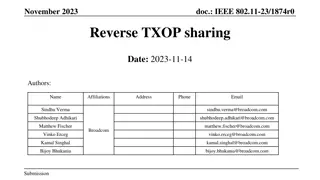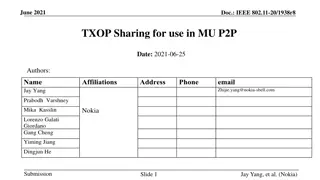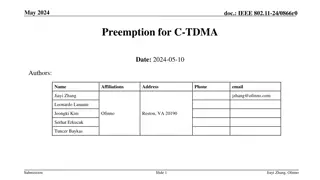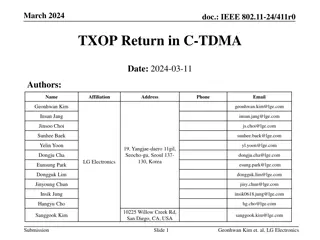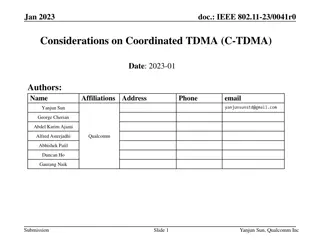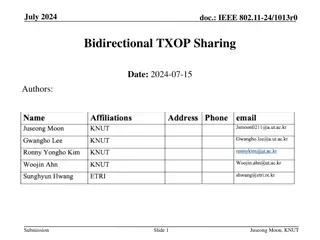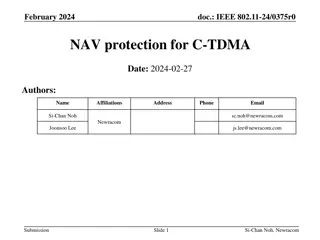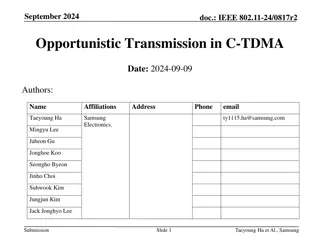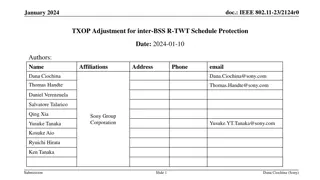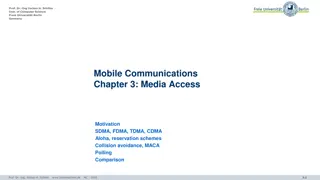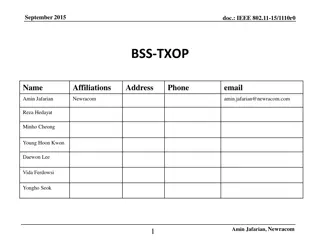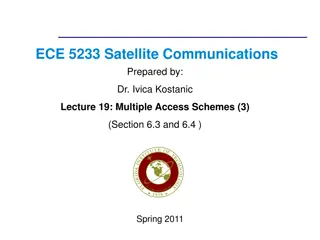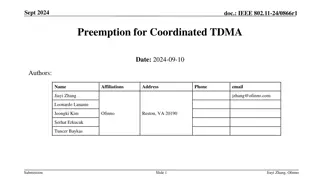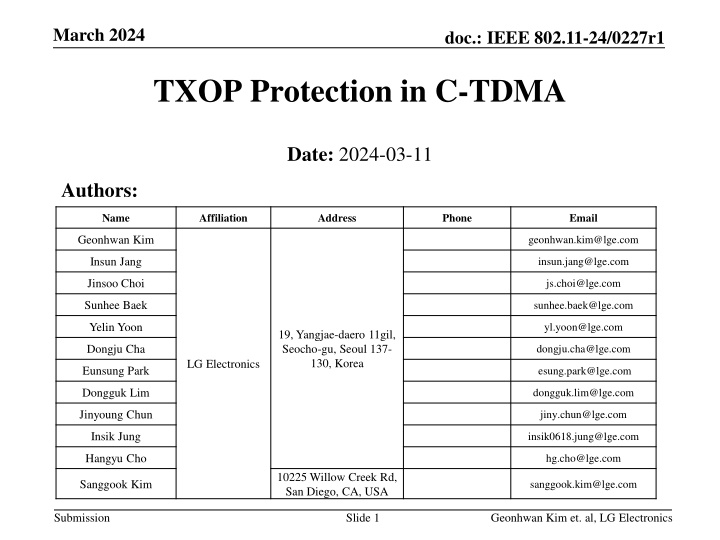
Enhancing WLAN Reliability: C-TDMA TXOP Protection in IEEE 802.11-24
"Explore the critical need for coordination in WLAN reliability between neighboring APs in overlapping scenarios through C-TDMA. Discover the advantages, procedures, protection issues, and hidden node problems addressed in the proposed solution by LG Electronics."
Download Presentation

Please find below an Image/Link to download the presentation.
The content on the website is provided AS IS for your information and personal use only. It may not be sold, licensed, or shared on other websites without obtaining consent from the author. If you encounter any issues during the download, it is possible that the publisher has removed the file from their server.
You are allowed to download the files provided on this website for personal or commercial use, subject to the condition that they are used lawfully. All files are the property of their respective owners.
The content on the website is provided AS IS for your information and personal use only. It may not be sold, licensed, or shared on other websites without obtaining consent from the author.
E N D
Presentation Transcript
March 2024 doc.: IEEE 802.11-24/0227r1 TXOP Protection in C-TDMA Date: 2024-03-11 Authors: Name Affiliation Address Phone Email Geonhwan Kim geonhwan.kim@lge.com Insun Jang insun.jang@lge.com Jinsoo Choi js.choi@lge.com Sunhee Baek sunhee.baek@lge.com Yelin Yoon yl.yoon@lge.com 19, Yangjae-daero 11gil, Seocho-gu, Seoul 137- 130, Korea Dongju Cha dongju.cha@lge.com LG Electronics Eunsung Park esung.park@lge.com Dongguk Lim dongguk.lim@lge.com Jinyoung Chun jiny.chun@lge.com Insik Jung insik0618.jung@lge.com Hangyu Cho hg.cho@lge.com 10225 Willow Creek Rd, San Diego, CA, USA Sanggook Kim sanggook.kim@lge.com Submission Slide 1 Geonhwan Kim et. al, LG Electronics
March 2024 doc.: IEEE 802.11-24/0227r1 Introduction PAR for 11bn (UHR) [1] highlights the need for coordination to enhance WLAN reliability between neighboring APs in overlapping BSS scenarios. To this end, various Multi-AP coordination schemes are being discussed [2]-[6], and coordinated TDMA (C-TDMA) [7]-[10] is one of the candidate schemes. The main advantage of C-TDMA would be reduced latency [11]. C-TDMA can utilize the Triggered TXOP Sharing (TXS) protocol in 11be (EHT) to achieve time-based coordination with neighboring APs. However, time-based coordination with neighboring APs can fundamentally cause protection and hidden node issues between overlapping BSSs. Therefore, C-TDMA should be designed carefully to avoid these problems. In this contribution, we propose a single AP TXOP sharing sequence focusing on TXOP protection and hidden node issues in C-TDMA operation. Submission Slide 2 Geonhwan Kim et. al, LG Electronics
March 2024 doc.: IEEE 802.11-24/0227r1 Recap: Expected C-TDMA Procedure We presented our view on the overall procedures required for C-TDMA in a previous contribution [12]. In order to support C-TDMA based transmission (i.e., frame exchanges within the allocated time) in 11bn, the following procedures need to be defined and preceded: Among these, Multi-AP selection and TXOP sharing procedures need to be carefully examined. To prevent TXOP protection issues and hidden node problems that may occur between coordinated BSSs. Submission Slide 3 Geonhwan Kim et. al, LG Electronics
March 2024 doc.: IEEE 802.11-24/0227r1 Recap: Protection Issues in C-TDMA We have raised some protection issues in the C-TDMA operation [13]. A solution is needed to prevent protection issues caused by coordinated BSSs (i.e., a sharing AP or non-AP STAs associated with the sharing AP). Set the Duration field of the MU-RTS TXS TF transmitted by the sharing AP to 0 [8] Ignore the basic NAV based on the coordinated information [8] Set the TXOP of the sharing AP to be short (or) Send CF-End before TXOP sharing [14] Finally, a Nominal TXOP duration for C-TDMA operation was presented [14]. Submission Slide 4 Geonhwan Kim et. al, LG Electronics
March 2024 doc.: IEEE 802.11-24/0227r1 Hidden node problems in C-TDMA Hidden Node Case 1) STAs (STA 2 in fig.) around the shared AP and hidden from the sharing AP TXOP sharing may fail. Hidden Node Case 2) STAs (STA 1 in fig.) around the sharing AP and hidden from the shared AP TXOP return may fail. Submission Slide 5 Geonhwan Kim et. al, LG Electronics
March 2024 doc.: IEEE 802.11-24/0227r1 Shared AP protection To avoid Hidden Node Case 1), the BSS of the shared AP needs to be protected from nearby hidden STAs until the TXOP sharing is performed. The Duration field of the frame transmitted during the Multi-AP selection procedure can be set to ?????. This period ends with the reception of a CTS frame to avoid TXOP protection issue. Pros: It increases the TXOP sharing success rate because it protects the BSS of the shared AP. Cons: The greater the number of coordinated APs, the more extensive the protection (i.e., overprotection). The scope of overprotection can be reduced by transmitting the Multi-AP selection req. frame to only a single AP. Submission Slide 6 Geonhwan Kim et. al, LG Electronics
March 2024 doc.: IEEE 802.11-24/0227r1 Sharing AP protection (1/2) To prevent Hidden Node Case 2), the sharing AP needs to be protected after TXOP sharing. To do this, the Duration field of the MU-RTS TXS TF can be set to ??????. (i.e., Allocated time). However, STAs (assoc. with a sharing AP) that cannot hear CTS frame for the MU-RTS TXS TF are permitted to reset their NAV when the NAVTimeout period expires. As a result, they may occupy the medium, and collision may occur if STAs also transmit a frame at the time the sharing AP receives the TXOP return frame. To solve this problem, the following options can be considered: Option 1) New indication bit can be included within the MU-RTS TXS TF. Based on the indication bit, NAV is not reset even if the NAVTimeout period expires. There is no additional overhead, but this option is only applicable to UHR STAs. Option 2)The sharing AP can send separate CTS frame (RA field = shared AP s MAC addr.) STAs (including legacy STAs) that receive this CTS frame maintain the NAV. However, there is overhead due to additional CTS frame transmission. Submission Slide 7 Geonhwan Kim et. al, LG Electronics
March 2024 doc.: IEEE 802.11-24/0227r1 Sharing AP protection (2/2) However, due to the duration of the MU-RTS TXS TF, TXOP protection issues may occur in the shared AP s BSS. This can be solved by setting the RA field of MU-RTS TXS TF to the shared AP s addr. (Intra-BSS NAV) As a result, the duration of the MU-RTS TXS TF is ??????., so the sharing AP s BSS is protected from nearby hidden STAs until the TXOP return. Pros: Although the TXOP return is somewhat guaranteed, it is still possible to fail [15]. With the failure of TXOP return in mind, the sharing AP can finish its individual transmissions before sharing a TXOP (i.e., no TXOP return is required) [16]. Cons (1): Sharing AP reserves the medium without performing FEs, resulting in poor channel utilization. Cons (2):It also doesn t follow the baseline (e.g., separate CTS frame & RA field of MU-RTS TXS TF). Submission Slide 8 Geonhwan Kim et. al, LG Electronics
March 2024 doc.: IEEE 802.11-24/0227r1 Summary In this contribution, we introduced a single AP TXOP sharing sequence focusing on TXOP protection and hidden node issues in C-TDMA. Shared AP protection helps TXOP sharing for the shared AP be performed. Sharing AP protection helps TXOP return for the sharing AP be performed. Shared AP protection is necessary to safely share TXOP to at least the first AP. However, the sharing AP protection has more disadvantages than advantages. The protection methods presented in this contribution may have the disadvantage of being basically overprotective, but targeting only a single AP can reduce the impact of overprotection. Therefore, in C-TDMA design, an appropriate trade-off is required between fairness with legacy STAs and the efficiency of C-TDMA. Submission Slide 9 Geonhwan Kim et. al, LG Electronics
March 2024 doc.: IEEE 802.11-24/0227r1 References [1] 23/0480r3, UHR proposed PAR [2] 22/1515r0, A candidate feature: Multi-AP [3] 22/1895r0, Thoughts on M-AP Coordination Principles [4] 23/767r0, M-AP Coordination Agreement [5] 23/616r0, Overhead Analysis of Coordinated Spatial Reuse [6] 23/1461r0, Considerations on Multi-AP Operation [7] 23/0041r0, Considerations on Coordinated TDMA (C-TDMA) [8] 23/0249r1, Extended TXOP Sharing [9] 23/0261r0, C-TDMA procedure in UHR [10] 23/0739r1, Follow-up on Coordinated TDMA (C-TDMA) [11] 23/1962r1, Gain analysis for coordinated AP transmissions [12] 23/1912r1, Coordinated TDMA Procedure [13] 23/1085r0, Thoughts on Coordinated TDMA [14] 23/1910r1, Coordinated TDMA (Follow up) [15] 24/0441r0, TXOP Return in C-TDMA [16] 24/0093r1, NAV setting for Coordinated TDMA Submission Slide 10 Geonhwan Kim et. al, LG Electronics
March 2024 doc.: IEEE 802.11-24/0227r1 Straw Poll 1 Do you agree to add the following text to the TGbn SFD? The Duration field of the initial frame transmitted within the TXOP obtained by the sharing AP is set to the time until the CTS frame is received in the TXOP sharing procedure. Submission Slide 11 Geonhwan Kim et. al, LG Electronics
March 2024 doc.: IEEE 802.11-24/0227r1 Straw Poll 2 Do you agree to add the following text to the TGbn SFD? The Duration field of the initial frame transmitted by the shared AP shall be set to equal or less than the time allocated in the MU-RTS TXS TF. Submission Slide 12 Geonhwan Kim et. al, LG Electronics

